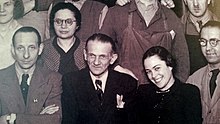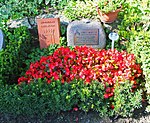Otto Weidt
Otto Max August Weidt (born May 2, 1883 in Rostock ; † December 22, 1947 in Berlin ) was the owner of a workshop for the blind in Berlin . As a young man, Weidt was involved in the anarchist labor movement . During the Holocaust , Weidt stood protectively in front of his Jewish employees and saved the lives of several Jews. Posthumously in 1971 he was honored as Righteous Among the Nations .
Life
Otto Weidt, son of the upholsterer Max Weidt and Auguste Grell, moved with his family from Rostock to Berlin as a child. Like his father, he learned the profession of upholsterer. He was a staunch pacifist ; he was able to avoid being used in the First World War thanks to an ear disease.
In 1913 Weidt married the tailor Martha Karoline Gustava Konieczny. The marriage ended in divorce in 1918. In 1919 he married the porter Johanna Stoll in his second marriage. In 1928 this marriage also ended in divorce.
In the early 1940s Weidt was married for the third time without children. Blinded himself, he opened a workshop for the blind at Rosenthaler Straße 39 as a broom and brush making shop. It was an "important military operation" because he mainly sold his products to the Wehrmacht . Through good relationships, bribery , forgery of passports and with the support of Hedwig Porschütz , Weidt managed to look after his mostly Jewish employees and initially protect them from the deportations that began. Inge Deutschkron , Hans Israelowicz and Alice Licht were among them .
He was able to place the twins Anneliese and Marianne Bernstein, born in 1922, with Hedwig Porschütz. She took them both into her small apartment, looked after them and ensured their survival.
With great effort Otto Weidt organized the supply of at least 25 people who were imprisoned in the Theresienstadt ghetto with food packages that were sent using numerous bogus senders. Of the thoughtful people, three survived; the others were deported to the Auschwitz-Birkenau extermination camp in autumn 1944 and murdered there.
He hid the Horn family in a back room of his workshop until they were betrayed by a Gestapo spy nine months later. Shortly before the end of the war, he went to Auschwitz to get in touch with his friend Alice Licht and to help her escape. When she was used in ammunition production in Christianstadt , he rented a room for her there. During the death march from the Groß-Rosen subcamp , she was able to flee and found shelter in the room. Then she went into hiding with the Weidts in Berlin and later emigrated to the USA.
After the war, Weidt campaigned for the construction of a Jewish orphanage and an old people's home for concentration camp survivors.
Otto Weidt died in Berlin in 1947 at the age of 64. He was buried in the Zehlendorf cemetery . By resolution of the Berlin Senate , Otto Weidt's final resting place (field 22 U 319) has been dedicated to the State of Berlin as an honorary grave since 1994 . The dedication was extended in 2018 by the usual period of twenty years.
In 1993, on the initiative of Inge Deutschkron, a memorial plaque was placed in his honor on the house at Rosenthaler Strasse 39. Weidt's former workshop is now a museum run by the German Resistance Memorial Center .
Memorial plaque
on the house at Rosenthaler Straße 39, in Berlin-MitteMemorial plaque
on the house at Salzachstrasse 6 in Berlin-ZehlendorfHonorary grave
at the Berlin cemetery in Zehlendorf
literature
- Inge Deutschkron , Lukas Ruegenberg: Papa Weidt: He defied the Nazis. Butzon & Bercker, Kevelaer 2001, ISBN 3-7666-0210-1 .
- Robert Kain: Otto Weidt. Anarchist and “Righteous Among the Nations” (Writings of the German Resistance Memorial Center / Series A / Analyzes and Representations; Volume 10). Lukas Verlag, Berlin 2017, ISBN 978-3-86732-271-3 ( full text in excerpt online ).
- Robert Kain: Pierre Ramus ' encounter with the later "silent hero" Otto Weidt. In: Knowledge , Vol. 19, No. 19 (2011), pp. 82–89; ramus.at (PDF; 836 kB).
- Robert Kain: Otto Weidt: From anarchist to “Righteous Among the Nations”. In: Hans Coppi , Stefan Heinz (ed.): The forgotten resistance of the workers - trade unionists, communists, social democrats, Trotskyists, anarchists and forced laborers. Dietz, Berlin 2012, ISBN 978-3-320-02264-8 , pp. 185-198.
- David Koser et al .: Otto Weidt workshop for the blind. In: Capital of the Holocaust. Places of National Socialist Racial Policy in Berlin. City Agency, Berlin 2009, ISBN 978-3-9813154-0-0 . Place 35, p. 154; Full text in excerpt (PDF; 1.3 MB) stadtagentur.de
Movie
- A blind hero - The love of Otto Weidt , director: Kai Christiansen . With Edgar Selge as Otto Weidt. Germany 2013.
Web links
- Website of the Otto Weidt workshop for the blind
- Otto Weidt, 1883–1947. From anarchist to “Righteous Among the Nations”. Research page for the dissertation of Robert Kain
- Otto Weidt, editor of the anarchist German Workers' Library in the database of German-speaking anarchism (DadA)
- Otto Weidt, co-editor of the anarchist magazine Der Anarchist in der DadA
- Exhibition "Blind Trust" ( Memento from August 24, 2007 in the Internet Archive )
- Otto Weidt - his work on saving the lives of Jews during the Holocaust , on the Yad Vashem website
Individual evidence
- ↑ Marriage register StA Schöneberg I, No. 175/1913
- ↑ Marriage register StA Berlin I / II, No. 902/1919
- ^ Hans-Jürgen Mende : Lexicon of Berlin burial places . Pharus-Plan, Berlin 2018, ISBN 978-3-86514-206-1 , p. 679.
- ↑ Honorary graves of the State of Berlin (as of November 2018) . (PDF, 413 kB) Senate Department for the Environment, Transport and Climate Protection, p. 91; accessed on March 18, 2019. Recognition and further preservation of graves as honorary graves of the State of Berlin . (PDF, 369 kB) Berlin House of Representatives, printed matter 18/14895 of November 21, 2018, p. 1 and Annex 2, p. 13; accessed on March 18, 2019.
- ^ Film website at ARD .
| personal data | |
|---|---|
| SURNAME | Weidt, Otto |
| ALTERNATIVE NAMES | Weidt, Otto Max August |
| BRIEF DESCRIPTION | Owner of a workshop for the blind, Righteous Among the Nations |
| DATE OF BIRTH | May 2, 1883 |
| PLACE OF BIRTH | Rostock |
| DATE OF DEATH | December 22, 1947 |
| Place of death | Berlin |




